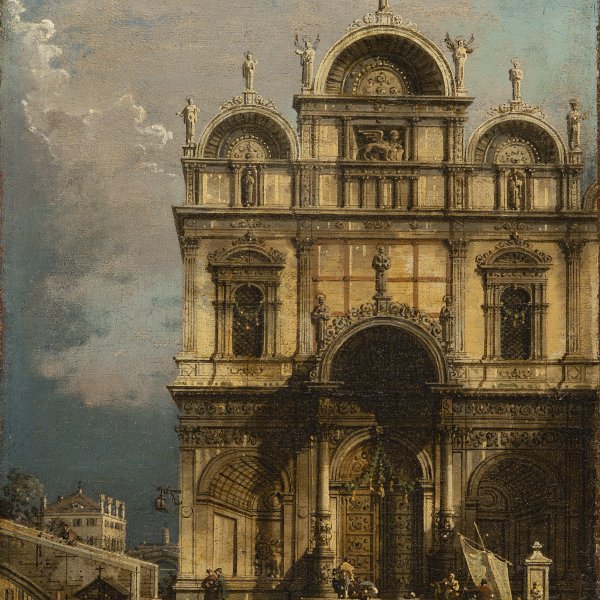The South Façade of Warwick Castle
1748
Oil on canvas.
75 x 120.5 cm
Museo Nacional Thyssen-Bornemisza, Madrid
Inv. no.
78
(1978.13
)
ROOM 17
Level 2
Permanent Collection
Canaletto visited England in 1746, arriving there in the spring. The celebrated Venetian artist travelled with a letter of recommendation from one of his most important protectors, Joseph Smith, the British consul in Venice. Canaletto was in Britain until 1755 and during these years made two trips to Venice, one of around eight months between 1750 and 1751 and the other in 1753. Dating from this English period are a series of paintings whose principal subjects are the city of London, the English countryside and other locations around the country. View of London through the Arch of Westminster Bridge in the collection of the Duke of Northumberland, The Thames and the City of London seen from Richmond House, belonging to the Trustees of Goodwood House, views of the area around Saint James’ Park and Westminster Abbey are among the scenes depicted during this new phase in the artist’s career. Among the artist’s distinguished clients, in addition to the Duke of Richmond, were Prince Lobkowicz, the 1st Duke of Northumberland, the 4th Duke of Bedford, and Francis Greville, 1st Earl of Warwick.
The present canvas was commissioned by Greville together with four more canvases, while also related to this commission are three drawings of Warwick Castle and two of the city of that name. The group, which is one of the most extensive by the artist devoted to a building in England, depicts the castle from different angles with the intention of reproducing the interior courtyard and the exterior façade. The present canvas may have been painted in Canaletto’s studio in London in Silver Street. From there it entered the collection of Francis Greville, who subsequently became the 1st Earl of Warwick. The canvas passed down by inheritance through the family until it was acquired for the Thyssen-Bornemisza collection in 1978. The South Façade of Warwick Castle belonged to the descendents of Francis Greville, including George and Henry Greville, and was displayed in various rooms in the castle, including the billiard room in 1853 and the breakfast room in 1893.
The principal element in the composition is the great mound of the castle depicted from the south side with its façade arranged on a slight diagonal that crosses the picture surface and is emphasized by the line of the river Avon and its bank that run parallel to the building. Seen from a hill, the far left of the painting features a garden while on the far right is the city of Warwick with its bridge. Canaletto used the foreground to locate figures engaged in leisure activities whose size provides a sense of scale for the monumental building behind them. Within this pleasant foreground scene is a gondola on the river, recalling the artist’s Venetian works. This detail, which might seem rather incongruous, can be related to an annotation in Francis Greville’s inventories that records the presence of a pleasure boat. The date of the painting has been established in relation to the date of Canaletto’s arrival in Britain as well as various alterations made to the castle in order to modernize it following Greville’s marriage to Elizabeth Hamilton in 1742.
Mar Borobia
The present canvas was commissioned by Greville together with four more canvases, while also related to this commission are three drawings of Warwick Castle and two of the city of that name. The group, which is one of the most extensive by the artist devoted to a building in England, depicts the castle from different angles with the intention of reproducing the interior courtyard and the exterior façade. The present canvas may have been painted in Canaletto’s studio in London in Silver Street. From there it entered the collection of Francis Greville, who subsequently became the 1st Earl of Warwick. The canvas passed down by inheritance through the family until it was acquired for the Thyssen-Bornemisza collection in 1978. The South Façade of Warwick Castle belonged to the descendents of Francis Greville, including George and Henry Greville, and was displayed in various rooms in the castle, including the billiard room in 1853 and the breakfast room in 1893.
The principal element in the composition is the great mound of the castle depicted from the south side with its façade arranged on a slight diagonal that crosses the picture surface and is emphasized by the line of the river Avon and its bank that run parallel to the building. Seen from a hill, the far left of the painting features a garden while on the far right is the city of Warwick with its bridge. Canaletto used the foreground to locate figures engaged in leisure activities whose size provides a sense of scale for the monumental building behind them. Within this pleasant foreground scene is a gondola on the river, recalling the artist’s Venetian works. This detail, which might seem rather incongruous, can be related to an annotation in Francis Greville’s inventories that records the presence of a pleasure boat. The date of the painting has been established in relation to the date of Canaletto’s arrival in Britain as well as various alterations made to the castle in order to modernize it following Greville’s marriage to Elizabeth Hamilton in 1742.
Mar Borobia









